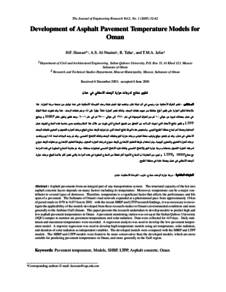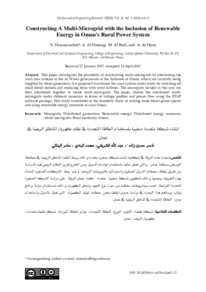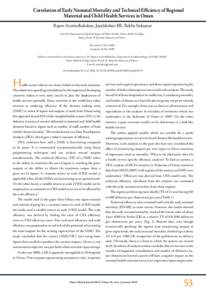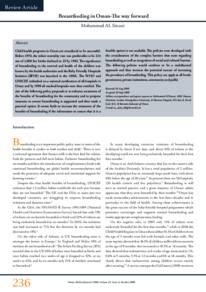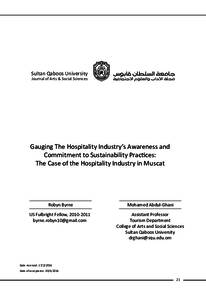Document
Development of asphalt pavement temperature models for Oman.
Contributors
Publisher
Sultan Qaboos University
Gregorian
2005
Language
English
English abstract
Asphalt pavements form an integral part of any transportation system. The structural capacity of the hot mix asphalt concrete layers depends on many factors including its temperature. Moreover, temperature can be a major contributor to several types of distresses. Therefore, temperature is a significant factor that affects the performance and life span of a pavement. The Sultanate of Oman's road network expanded at a phenomenal pace from approximately 10 km of paved roads in 1970 to 9,673 km in 2001. with the recent SHRP and LTTP research findings, it was necessary to investigate the applicability of the models developed from these research studies to Oman's environmental conditions and more generally to the Arabian Gulf climate. This paper presents the research undertaken to develop models to predict high and low asphalt pavement temperatures in Oman. A pavement monitoring station was set-up at the Sultan Qaboos University (SQU) campus to monitor air, pavement temperatures and solar radiation. Data were collected for 445 days. Daily minimum and maximum temperatures were recorded. A regression analysis was used to develop the low pavement temperature model. A stepwise regression was used to develop high temperature models using air temperature, solar radiation, and duration of solar radiation as independent variables. The developed models were compared with the SHRP and LTPP models. The SHRP and LTPP models were found to be more conservative than the developed models, which are more suitable for predicting pavement temperatures in Oman, and more generally in the Gulf region.
Member of
ISSN
1726-6742
Resource URL
Citation
Hassan, H. F., Al-Nuaimi, A. S., Taha, R., & Jafar, T. M. A. (2005). Development of asphalt pavement temperature models for Oman. The Journal of Engineering Research, 2 (1), 32-42.
Arabic abstract
تعتبر الطرق الاسفلتية جزء رئيسي في أي شبكة نقل، وتعتمد قوة تحمل طبقة رصف الخرسانة الاسفلتية على عدة عوامل من ضمنها درجة الحرارة. هذا بالإضافة لتأثير الحرارة على ظهور أنواع مختلفة من عيوب طبقات الرصف. ولذلك تعتبر الحرارة عاملا مؤثرا على أداء وعمر طبقات الرصف. هذا وقد تطورت شبكة الطرق في عمان بمعدلات كبيرة من حوالي 10 كم من الطرق المرصوفة في عام 1970 إلى حوالي 9700 كم في عام 2001. وبعد ظهور وتطور نظام SHRP وبرنامج LTPP وظهور نتائج الأبحاث التي أجريت كان لابد من التحقق من تطبيق النماذج التي طورت من خلال هذا النظام وتحديد مدى مناسبة هذه النماذج لظروف عمان المناخية وبصفة أعم لمناخ منطقة الخليج العربي. وتستعرض هذه الورقة نتائج البحث الذي تم إجراؤه لإيجاد نماذج لتوقع درجات الحرارة القصوى والصغرى لطبقات الرصف الأسفلتي في عمان. وقد تم تجهيز موقع وتركيب محطة لقياس درجات حرارة الجو وطبقات الرصف وكذلك الإشعاع الشمسي. وقد تم رصد البيانات لمدة 445 يوم وتحديد درجات الحرارة القصوى والصغرى اليومية، وتم استخدام طريقة التحليل الانحداري لإيجاد نموذج لدرجات الحرارة الصغرى، وطريقة التحليل الانحداري ذو خطوات لإيجاد نموذج الدرجات الحرارة القصوى باستخدام درجة حرارة الجو والإشعاع الشمسي وكذلك فتره الإشعاع الشمسي كمتغيرات مستقلة. وقد تم مقارنة النماذج المطورة في هذه الدراسة مع نماذج SHRP و LTPP وتبين من المقارنة أن النماذج الأخيرة أكثر تحفظا من النماذج المطورة في هذه الدراسة والتي تعتبر أكثر ملائمة لتوقع درجات حرارة الرصف الأسفلتي في عمان وبصفة عامة في منطقة الخليج.
Category
Journal articles

